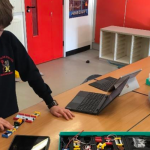Many teachers and families are starting to combine games in their children’s learning process. That is because game-based learning is gaining popularity among educational experts around the world. Our post focuses on what game-based education is and how it affects child development. We also try to make some suggestions for game-based learning activities.
What Is Game-Based Learning?
Game-based learning is a teaching method designed to incorporate the learning subject with gameplay. In this method, students and teachers play games that may contribute to the learning experience by simplifying and exemplifying certain subject matters and concepts. The purpose of game-based education is to qualify students to apply the abilities they obtain during playing to real-life scenarios. Game-based learning in the classroom provides a safe and comfortable environment for children to make mistakes, take actions, practice behaviours, and experience the consequences of their choices without taking real-life risks.
Although some people believe that game-based learning and gamification are simply the same methods, they are different at the core. So, they should not be treated as the same concepts. Instead, gamification means applying the elements of games – such as points, achievement tracks and rankings – to non-game classroom activities.
Benefits Of Game-Based Learning On Child Development
Game-based learning has many proven benefits for child development. For example, a study in 2018 established the “evidence that the use of educational games could support and increase the mathematics learning outcomes.” Another research remarks that “educational games play a successful role in terms of both a better understanding of the course content by the students and the participation of the students in this process.”
Improves Problem Solving Skills
Games usually work with the idea that the players should complete a series of challenges to win. Completing the tasks in the shortest time among other players can be either a requirement or an extra score, though it can be both. Integrating games into classroom activities develops children’s logic and ability to come up with solutions quickly. So, games help children react to obstacles and create solutions quickly.
Boosts Critical Thinking Abilities
Almost every course, every branch of study builds itself upon critical thinking abilities as they need students to think and create ideas. Game-based curriculum merges learning outcomes with gameplay to get students to develop critical thinking skills like analysing and creating ideas rather than just reading and memorising.
Encourages Students’ Engagement
Sometimes getting students involved in classroom activities may be hard for teachers. A child’s attention can be hard to attract; it is even hard to keep a classroom of kids interested and engaged in the subject matter. The teaching subjects may be too irrelevant for children at that age, or they just do not want to spend time reading textbooks, sitting and listening to the teacher for long periods. Game-based learning in the classroom is quite helpful in getting kids interested in science or any school course. Games are perfect ice breakers even for the children who are too shy to involve in the classroom. Playing games about the learning subjects keeps students engaged. As they actively work on the matter, they can more easily grasp the topic’s meaning.
Motivates Students for Learning
Teachers often urge their students to practice the learned subject to internalise what they learned. However, many students find revising boring and just leave it to later. Game-based learning might be what they need to make science fun and accessible! Some games require some knowledge on the matter to skip levels or overcome rivals. This sparkles kids’ competitive sides and motivates them to study the school subjects to win the games.
Types of Game-Based Learning
There are lots of games, both physical and digital. Many of those can be linked to school subjects or critical and creative thinking skills. So yes, games are great fun activities, but they are also great teachers that help children develop essential abilities.
Board Games
One can find any kind of board game suitable for the number of players, their age, abilities and the target learning subject. Board games can attract almost every child’s attention – from toddlers to high school children. For example, the puzzle is a great game to develop children’s abilities to distinguish little details, apply trial and error methods, and form the bigger picture in their minds. One can find puzzles for every age group. Likewise, chess is like a simulation game that improves children’s strategical thinking skills. It is not only educational but also thrilling. Card games also play a significant part in mathematic education; they develop strategic thinking and the ability to consider various factors simultaneously.
Real-Life Games
We all see little children play house, act like doctors, builders, chefs, etc. That kind of game prepares children for real life. Children practice how to react to the adult world, other people and some obstacles in their way. This way, when they face real situations later in their lives, they apply what they have practised in their safe space while playing. Word games are another important element of game-based learning. They expand children’s vocabulary, teach them new phrases, and how to think quickly.
Digital Games
The world is evolving, and every day comes with new technological changes. Digital games are one of those evolving parts of the world. They provide a whole new universe where players can get in touch with other people around the globe, experience virtual life situations, etc. Many simple games allow children to do experiments and teach them colours, rules of physics, mathematics and thinking skills. As there are infinite opportunities in that virtual universe, children can learn many great things. But one negative aspect of those games is that it makes managing screen time for kids difficult.
Game-Based Learning Activities for Children
We see game-based learning getting incorporated into the classroom more and more each day. Game-based learning activities vary in accordance with each child’s needs and interests. So, there will not be much difficulty if you want to try a game-based approach to teaching.
Mixing colours is a great hands-on activity for children. That game teaches children basic colour theory as the players combine primary colours to create secondary colours. Kids also learn basics about STEM as they learn how to produce new things out of the items at hand, how liquids mix, etc. Word games, like Scrabble, also teach children how to form meaningful words out of unarranged letters. This kind of game enlarges kids’ vocabulary and urges them to think practical.
The number of game-based learning apps has been increasing rapidly. Twin App offers a great diversity of interactive games, challenges and trivia. Our app introduces students and families to a hybrid learning experience in the 21st century. Students watch educational videos about STEM subjects and practise their knowledge through interacting with STEM activities in our app.
Interactive games provide a lot of activities in which children can learn more about physics, robotics, mechanics, etc. DIY challenges urge kids to do hands-on activities that boost their fine motor skills along with artistic and practical abilities. With trivia questions, children can refresh their STEM knowledge.You can find much more about games, challenges, and trivia in our Twin App!



